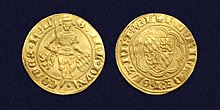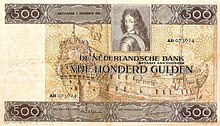Dutch guilder
| Dutch guilder | |
|---|---|
| Country: |
|
| Subdivision: | 100 cents |
| ISO 4217 code : | NLG |
| Abbreviation: | ƒ, fl, hfl, NLG |
|
Exchange rate : (fixed) |
1 EUR = 2.20371 NLG |
| Issuer : | De Nederlandsche Bank |
The Dutch guilder or Dutch guilder (French florin ) is the former currency of the Netherlands . It was replaced on January 1, 1999 by the euro as book money . The introduction of cash took place on January 1, 2002. Until January 28, 2002, the guilder was legal tender.
The currency symbol ƒ (also fl or hfl ) came from an older currency, the florin , Dutch florijn .
history

Duke Wilhelm I of Bavaria-Straubing had the first guilders minted in Holland in 1378 as Count Wilhelm V of Holland and Zealand . Even later, individual princes had guilders minted.
A Dutch state in the strict sense of the word was not created until 1581 with the republic of the Seven United Provinces . However, this republic did not issue any guilders. In the Netherlands, coins were minted under the designation guilder since 1601. In 1694 the Generaliteitsgulden was introduced. In the United Kingdom of the Netherlands , the monetary system was reorganized in 1814 after the Napoleonic Wars.
Among other things, the De Nederlandsche Bank was founded as a central bank , which was the first to issue banknotes in Holland. These were declared legal tender in 1904 .
1 guilder note from 1943, issued by the Dutch government- in- exile in London for use after the liberation of the Netherlands.
Coins and notes from 1945 to 2000
Before the introduction of the euro, the following nominal values were in circulation:
- Coins:
- 5 cents ( stuiver )
- 10 cents (Dubbeltje)
- 25 cents (Kwartje)
- 1 guilder
- 2½ guilders ( Rijksdaalder )
- 5 guilders
The ½ cent coins were withdrawn from circulation in 1948; the 1 cent coins on March 1, 1983. The 5 guilder coins were only introduced on May 1, 1988.
- Notes: 5, 10, 25, 50, 100, 250, 1000 Gulden
The 2.50 and 20 Gulden notes were in circulation until 1970; the 5 guilder notes were withdrawn from circulation in 1990.
The 50 guilder notes were issued in 1981 and the 250 guilder notes in 1986.
The 10 guilder note was possibly the world's first (1997 or earlier) banknote that was issued with the EURion constellation as a security function.

Euro introduction
The exchange rate is 1 euro = 2.20371 hfl. The ISO 4217 code is NLG. Coins were only exchanged until January 1, 2007, while notes can still be exchanged until January 1, 2032.
The currency denomination gulden still exists on the Caribbean islands of Curaçao and Sint Maarten ( Antilles guilder ) and on Aruba ( Aruba florin ).
Bonaire , Saba and Sint Eustatius changed from the Antilles guilder to the US dollar on January 1, 2011 . The reason for this was the dissolution of the Netherlands Antilles in October 2010.
Web links
Individual evidence
- ↑ Gld. / Hfl. / fl. / f. / f / NLG ( Memento from November 4, 2013 in the Internet Archive )
- ↑ De Nederlandsche Bank (English): Exchanging guilders ( Memento of the original from October 2, 2013 in the Internet Archive ) Info: The archive link has been inserted automatically and has not yet been checked. Please check the original and archive link according to the instructions and then remove this notice. , accessed September 29, 2013







